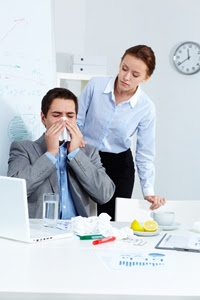November 18, 2015
All Articles
Search & Filter
Is your workforce ready for the upcoming flu season?

As the flu season approaches, be sure your employees are prepared.

Sickness in the workplace can have serious consequences when businesses are not prepared.
The pandemic H1N1 flu outbreak of 2009 was considered to be mild by the U.S. Centers for Disease Control and Prevention, but still created significant challenges for unprepared employers and their workers. By taking the necessary precautions early on, your business can keep its employees safe, while maintaining the best work practices possible.
According to the CDC, it’s not possible to predict what the exact flu season will be like, as the time, severity and length of the season varies year to year. The flu is also constantly changing, with different strains and viruses combining to make new kinds, which can affect people in different ways.
Most seasonal flu activity occurs between October and May, peaking most often between December and February.
For the 2015-2016 flu season, the Advisory Committee on Immunization Practices (ACIP), recommends annual influenza vaccinations for everyone six months and older.
How can employers protect their workers this flu season and from health risks in general?
- Encourage employees to take time off when necessary: According to the World Health Organization (WHO), work-related health problems result in an economic loss of 4-6 percent of GDP for most countries. This loss may not seem very big, but can add up over time. By encouraging employees to take time off when sick, management teams can stop the spread of diseases, as well as ensure workers can return to work faster than before. Flexible work leave policies stop the spread of germs and help maintain an overall healthier workforce.
- Know the signs of sickness: It may seem redundant to train workers on the signs of sickness or ill-health, as they have most likely experienced it throughout their lives, but training can help prevent serious spread of infections. With the continued emergence of smaller workplaces and closer working conditions, it’s important that employees maintain access to soap and running water, alcohol-based hand sanitizer, tissues and proper cleaning agents. Changes as simple as hanging up posters with proper health habits and handing out pamphlets on safety information can make a difference. Or have employees go through a short, online training program to brush on flu prevention tips.
- Maintain control over the space: Employers should be able to modify their work area at any time to ensure the health and safety of workers. By being able to conduct business in a different manner, use high-quality ventilation systems and installing hand sanitizer dispensers, employers are able to keep their environment sickness-free. By encouraging proper social distancing between employees, covering the facial area when coughing or sneezing, as well as cleaning work spaces frequently, sicknesses can be avoided.
Employee risk of exposure varies from very high to low, and can change due to different situations. Be sure your workers are prepared for the upcoming flu season with the latest training available.
Source


Great post relating to Health & Safety, we have recently posted a series of blogs on construction design management, please check it out and follow us for more H&S posts!